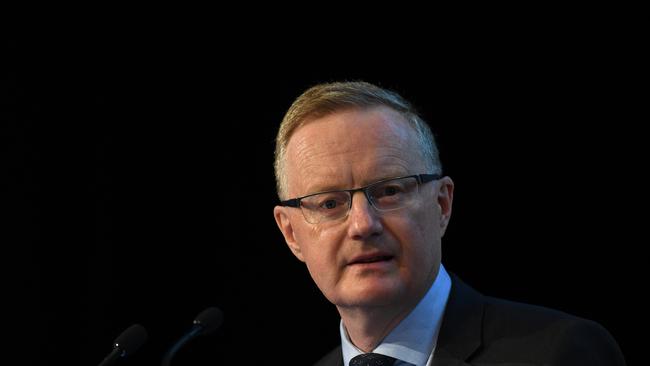Rate cut tipped amid virus crisis
The expectation of a Tuesday rate cut by the Reserve Bank has surged dramatically after a torrid week on global markets.

The likelihood of a Tuesday rate cut by the Reserve Bank has surged dramatically after a torrid week on global markets and indications from the US Federal Reserve that it will slash its benchmark rate later this month.
As local stocks joined in last week’s global rout, slumping 9.8 per cent due to a rapid escalation in coronavirus cases outside China, the market pricing for a 25 basis-point cut in local rates to 0.5 per cent spiked from 18 per cent on Friday to 87 per cent.
Investors were further shaken by a sharp decline in China’s manufacturing PMI, which tracks sentiment among purchasing managers at manufacturing businesses, to a record low.
The 15-year-old PMI index tumbled from 50 in January to 35.7 in February — low enough to indicate the country could have its first economic contraction since the end of the Cultural Revolution.
AMP Capital head of investment strategy Shane Oliver said the Australian economy was likely to shrink in the March quarter due to the impact of the bushfires and the virus, with the RBA’s employment and inflation objectives even further out of reach.
While a significant budgetary stimulus would be welcome, this was unlikely because of Scott Morrison’s preference for “targeted, modest and scalable” assistance to impacted sectors.
“The US Fed is effectively signalling it will cut rates in two weeks’ time, and if the biggest central bank in the world is worrying then we should be worrying as well,” Dr Oliver told The Australian.
“If the RBA leaves the cash rate unchanged and the Fed cuts by 50 basis points, there will be upward pressure on the Australian dollar which the RBA will want to avoid.”
Recent economic data, he said, was also soft.
Unemployment had climbed to 5.3 per cent, wages growth continued to flatline at 2.3 per cent, credit growth year-on-year was an anaemic 2.5 per cent, and construction and business investment figures were also weak.
December quarter GDP growth was likely to have further slowed.
“Against the background of already weak economic growth and the threat of further weakness to come, the benefits of another interest rate cut, which includes keeping the dollar down, likely outweigh the costs,” Dr Oliver said.
“I get the feeling that the RBA would probably prefer to wait a bit longer to better assess the coronavirus’s impact and see if there is a more ‘material’ rise in unemployment.
“But things are moving fast around the threat of coronavirus, with very sharp falls in sharemarkets warning that the threat to the growth outlook is very serious.”
Fed chairman Jerome Powell signalled on Friday that the central bank was prepared to cut interest rates to boost activity levels.
While the fundamentals of the US economy remained strong, Mr Powell said the coronavirus posed evolving risks to economic activity.
“The Federal Reserve is closely monitoring developments and their implications for the economic outlook,” he said.
“We will use our tools and act as appropriate to support the economy.”
Market observers noted that the Fed had used similar language last June, when it appeared the trade war between the US and China could worsen a global slowdown.
The central bank was true to its word, cutting interest rates three times to a range of 1.5-1.75 per cent.
It is now thought that US rates could be cut by at least 25 basis points, with Bank of America Merrill Lynch forecasting 50 basis points, at the Fed’s next scheduled meeting on March 17-18.
The last emergency rate cut occurred in 2008 during the GFC.
Local shares, meanwhile, suffered their worst slump last week since the GFC, as the S&P/ASX 200 index shed 697.8 points to 6441.2 and $210bn in value was erased from the bourse. While the half-year profit reporting season was better than expected, with dividends strong and more companies reporting profit increases than decreases, the market took its cue from virus-related news.
The notes from the Reserve Bank’s last monetary policy meeting on February 4 say directors felt it was too early to determine the extent to which growth in China would be affected, or the nature of the international spillovers.
Previous outbreaks of new viruses had led to significant but short-lived negative effects on activity in economies at the centre of the outbreak, although it was difficult to know how representative these earlier episodes could be.
“China now accounted for a much larger share of the global economy and was more closely integrated, including with Australia, than in 2003 at the time of the SARS outbreak,” the minutes say. The economic effects would depend crucially on the persistence of the outbreak the measures taken to contain its spread.”
In the US, Mr Powell’s statement reflected the same awareness of the scale of potential disruptions that has fallen over markets in recent days, but he didn’t signal how soon the Fed might act.
“If there’s a recession coming because the supply side of the economy has been hurt badly … the Fed isn’t going to put people back to work by lowering rates,” former Fed vice chairman Donald Kohn said.
“But the question is whether there are spillovers to demand.”
Additional reporting: The Wall Street Journal



To join the conversation, please log in. Don't have an account? Register
Join the conversation, you are commenting as Logout